Whether you’re planting a single avocado tree or an entire grove, you need to figure out the spacing. How close should you plant your avocado tree to your house or your driveway? How far should the tree be from another fruit tree or a retaining wall? Can you plant an avocado tree in a lawn? How close can you plant two or three avocado trees together?
I’m going to show photos of some of the planting decisions that I and others have made with avocado trees in various settings — noting reasons for and consequences of each. Hopefully, this will aid you in your planting decisions.
How close to a fence
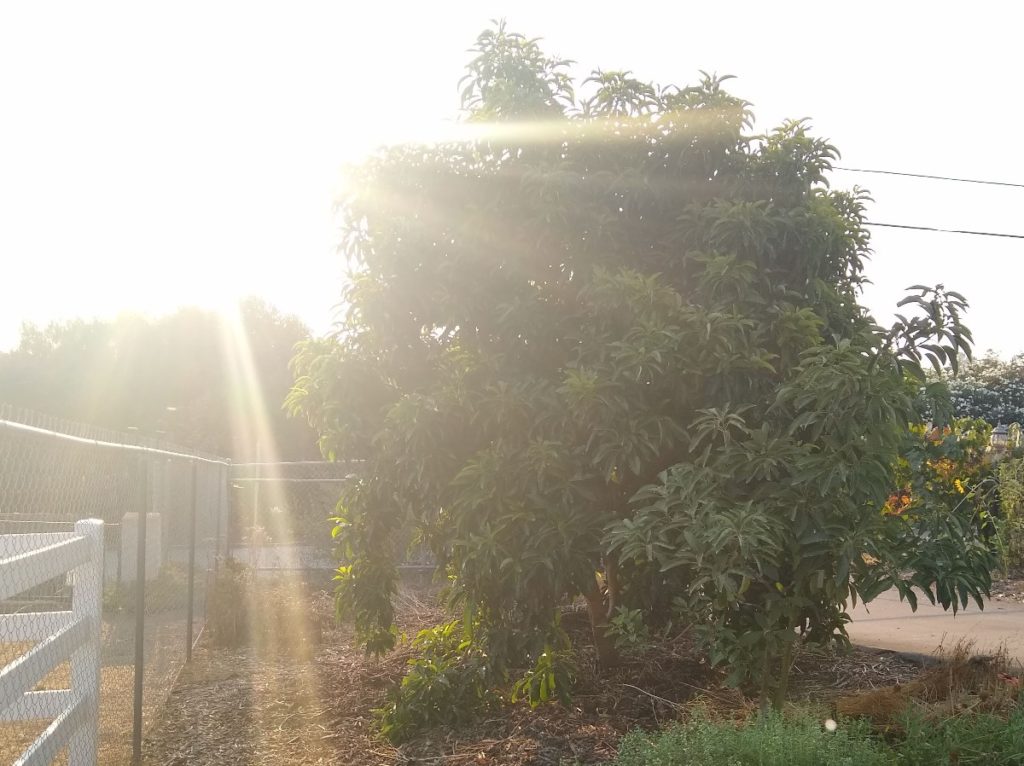
This is a Reed avocado tree that is seven years old and was planted about 11 feet from the fence. I can still easily walk between the fence and the tree, and I have yet to need to prune that side of the tree.
But Reed is not the most spreading of avocado varieties. Hass spreads more. Below is a Hass that is also seven years old but planted about 19 feet from the fence covered in grapes on the left.

This Hass has also not been pruned on the side facing the fence, and there is still ample space to walk through. Someday, however, I’m sure that both of these trees will need to be lightly pruned on the fence sides in order to maintain the paths.
How close to a wall, road, or sidewalk
If you don’t need to walk between a fence or wall and your avocado tree, then you can plant much, much closer — especially if you’re willing to let the tree grow up and over the fence or wall.

This is a large, old Fuerte near San Diego’s Balboa Park that was planted only about three feet from a stone wall with an iron fence atop.
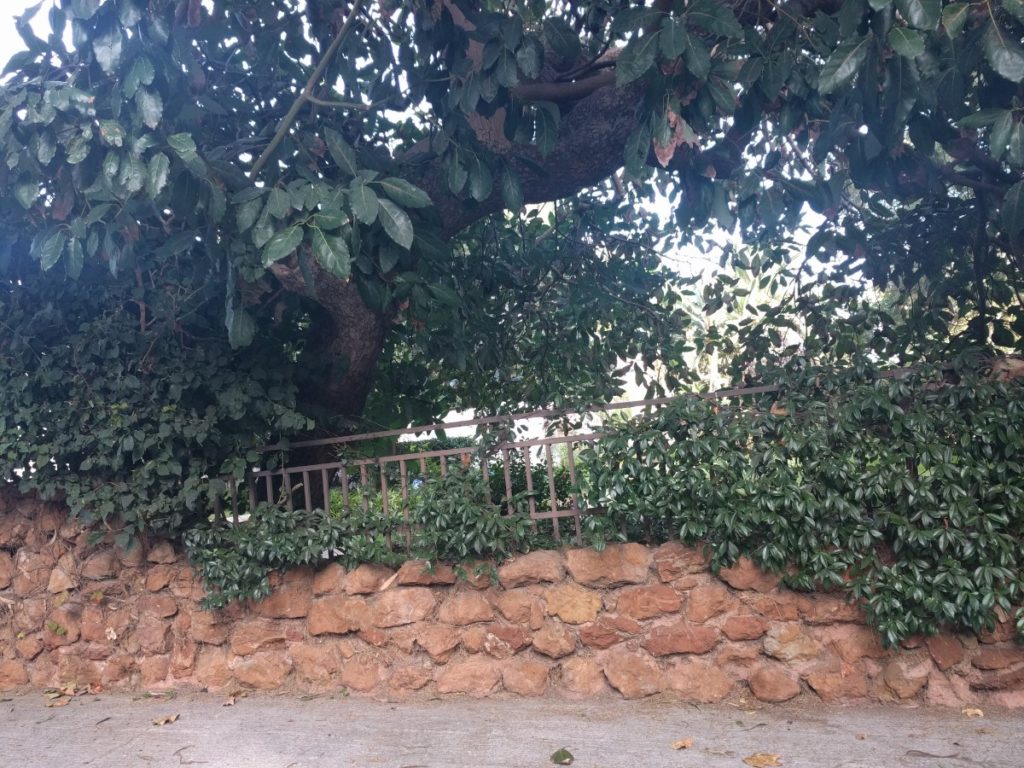
The Fuerte from the side. And below, a look down at the trunk.

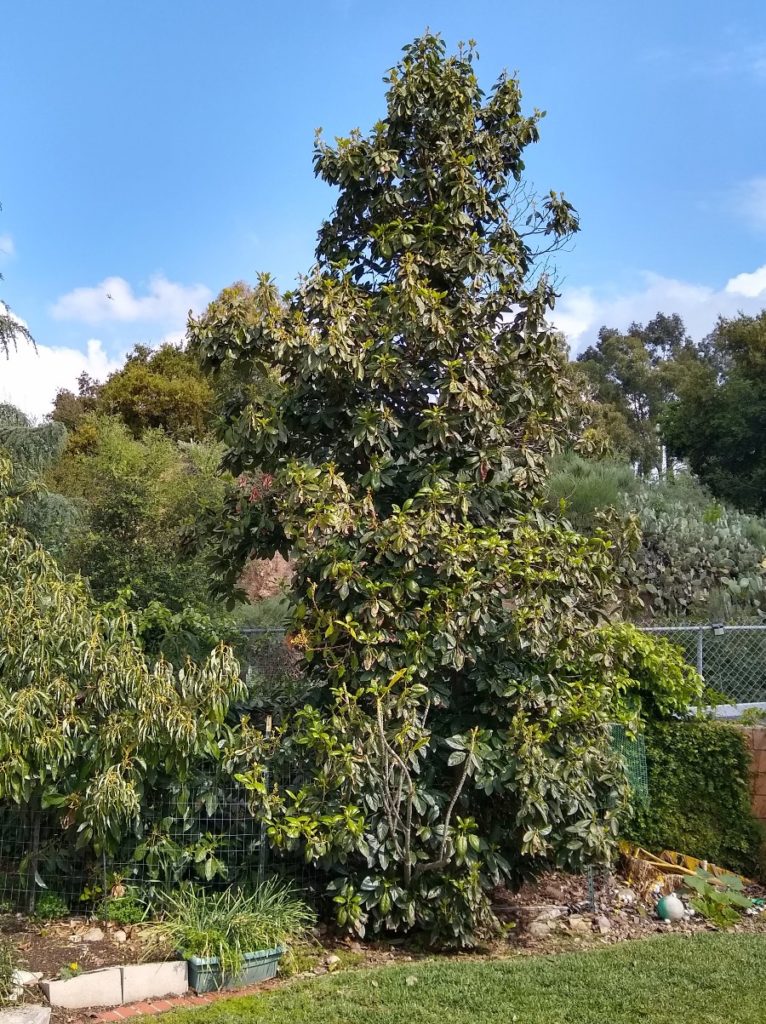
This tree was also planted just a few feet from a wall, but only around ten years ago. Neither this tree nor the large Fuerte above has damaged the nearby walls. Avocado tree roots don’t tend to do such damage, in my observations.
Here is an old Bacon avocado tree whose trunk is sandwiched between a paved street and a sidewalk, yet no buckling has occurred, unlike the certain buckling that would have occurred with some other tree species, such as live oak or sweet gum.
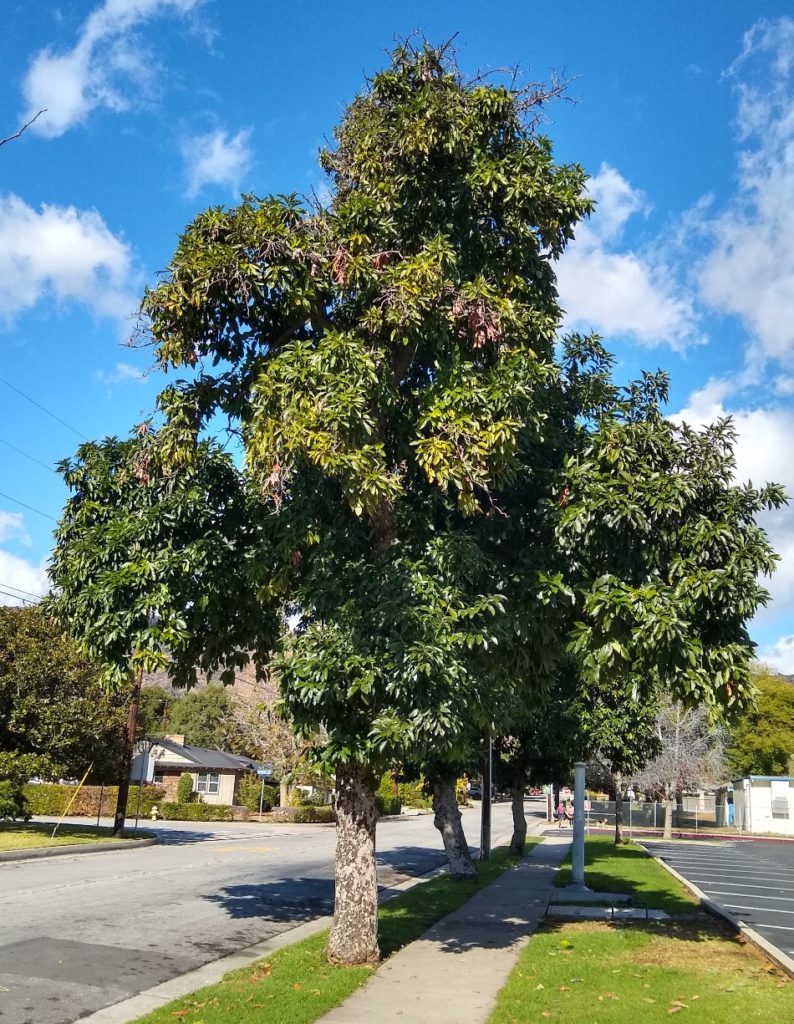
How close to a lawn
It is often said that you shouldn’t plant an avocado tree in the middle of a lawn. While I wouldn’t plant an avocado in a lawn if I had other sites available, it is possible to grow an excellent avocado tree within a lawn. Examples abound. Below is a fine specimen in Point Loma.

How close to a house
This avocado tree is in nearby Ocean Beach. It was planted about 15 feet from the houses on either side and provides wonderful shade for the patio beneath. Some trimming of branches is necessary toward the top, as you can see that they meet the roof of the second story.
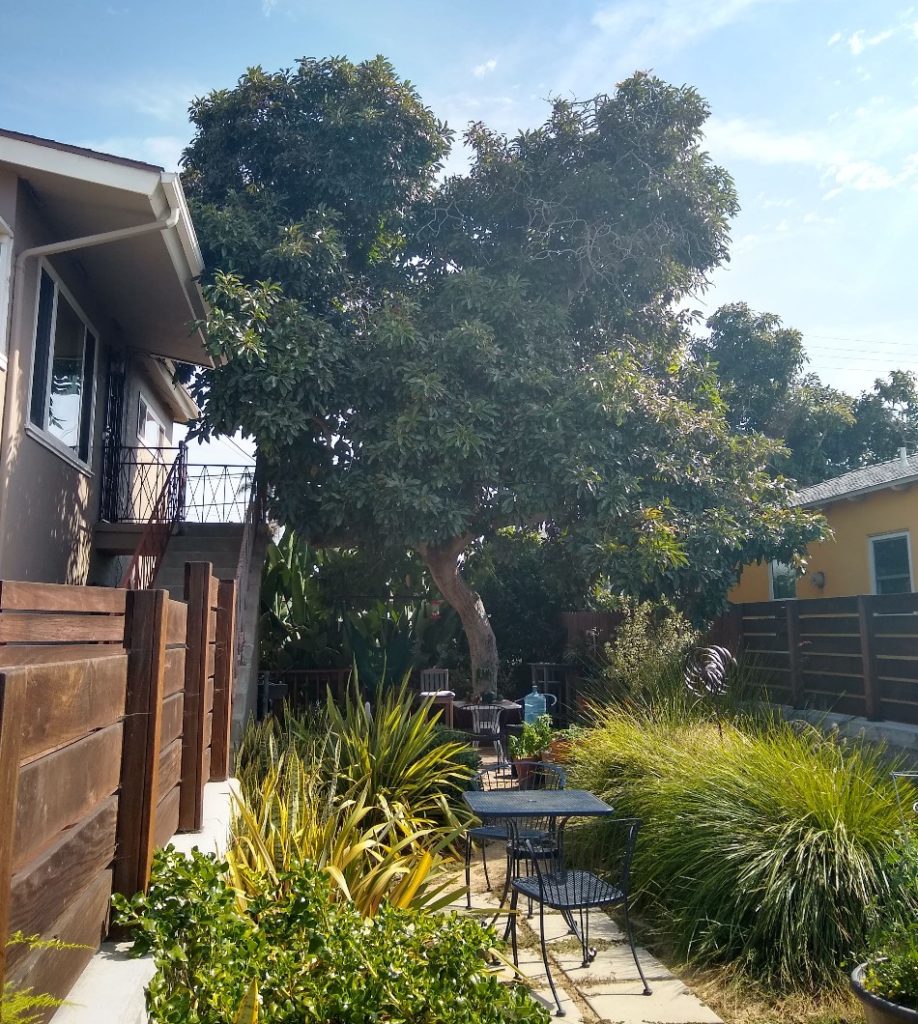
I’ve seen avocado trees planted closer to houses. In fact, I’ve planted avocado trees closer to my own house. That usually requires more pruning in the long run, depending on the variety planted. But I’ve never seen such avocado trees causing damage to the houses’ foundations. If irrigation water isn’t applied close to the house, it’s unlikely that many roots will grow there. Roots grow where the soil is moist.
How close to other trees
Below is a Hass tree in my yard that is around 17 feet tall and wide, and to the right of it is a Valencia orange tree that is around 25 feet tall. The distance from the trunk of the avocado to the trunk of the orange is 26 feet.
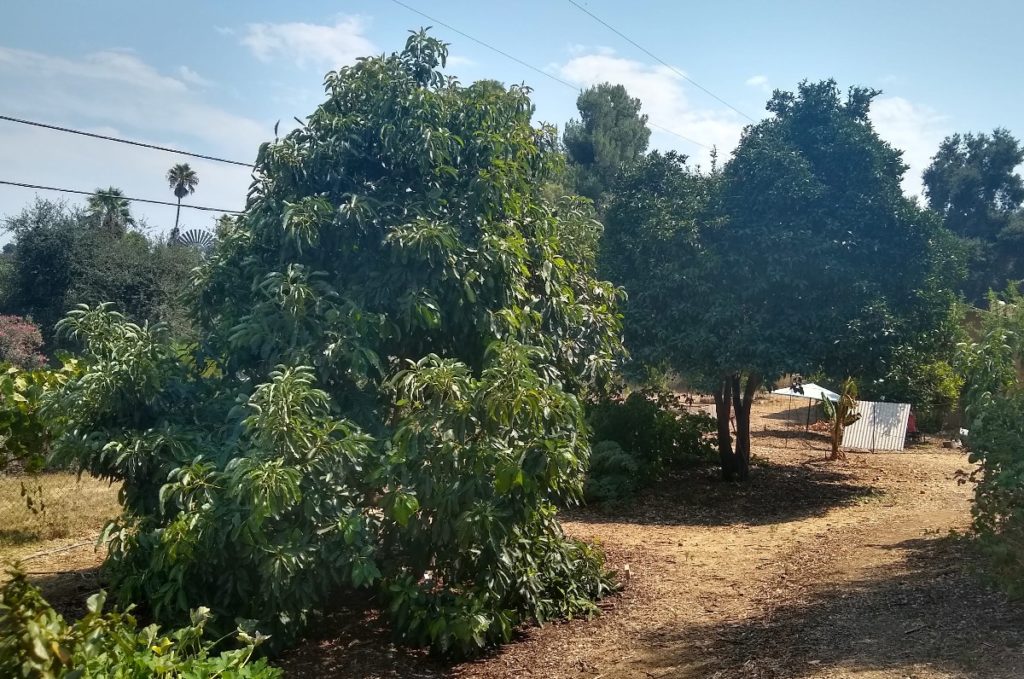
With minimal pruning to the avocado going forward, there will continue to be ample space to walk between the trees as well as enough sunlight in that path such that foliage and fruit will be produced all the way down to the ground.
Below is a Gwen avocado tree that I planted just east of a large live oak. In retrospect, I wish I had planted this Gwen elsewhere. Two problems have been encountered.
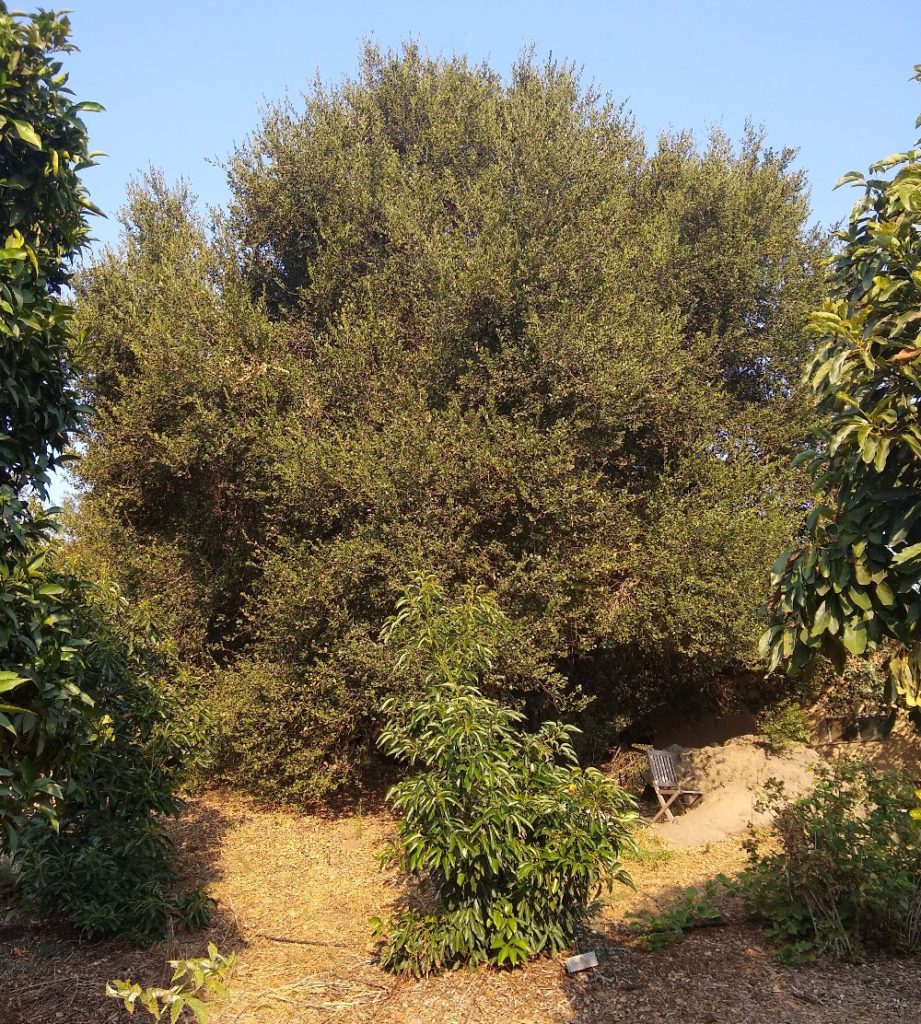
One, the afternoon shade from the oak is more than ideal. I’m convinced that the avocado would have grown faster and been more fruitful in a more sunny location. Two, the oak has grown many roots into the area where I give the avocado its water so I have to apply more water to compensate for the oak’s “theft.”
Something similar is going on in the photo below, where you’ll notice that the avocado trees on the left are smaller than those on the right, which are farther from the large oaks and pines.
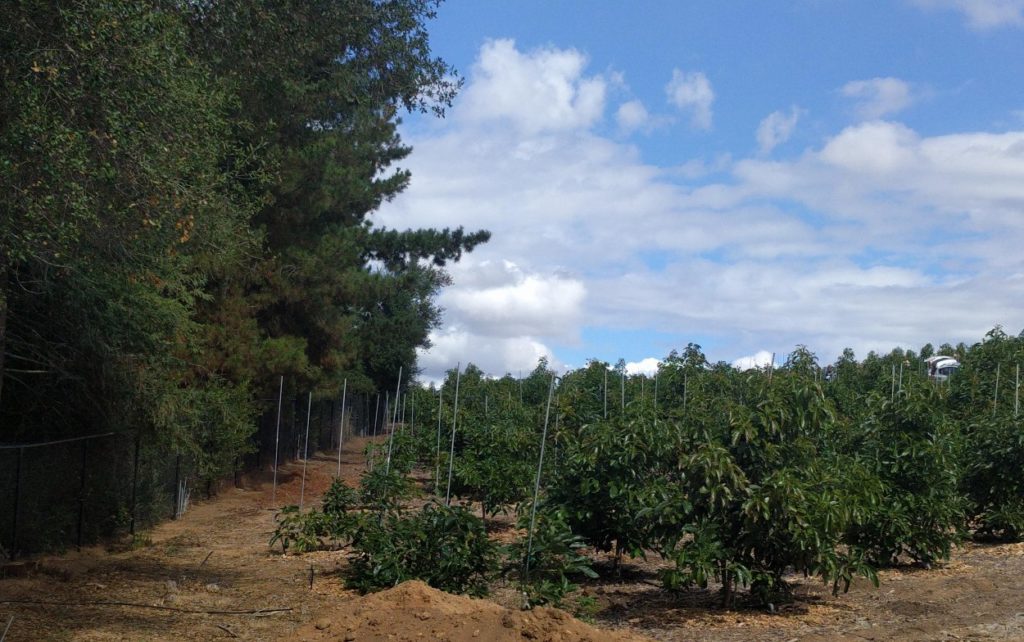
If you must plant near a large tree (and sometimes our yards offer no other choice, right?), just keep in mind that the large tree is likely to have these influences on your young avocado. Prune limbs from the large tree, apply extra water to the avocado, and prune the roots of the large tree out of the avocado’s zone using a shovel, as necessary or practical.
Here is a row of Hass avocado trees each planted 15 feet from one another on the campus of Cal Poly Pomona.
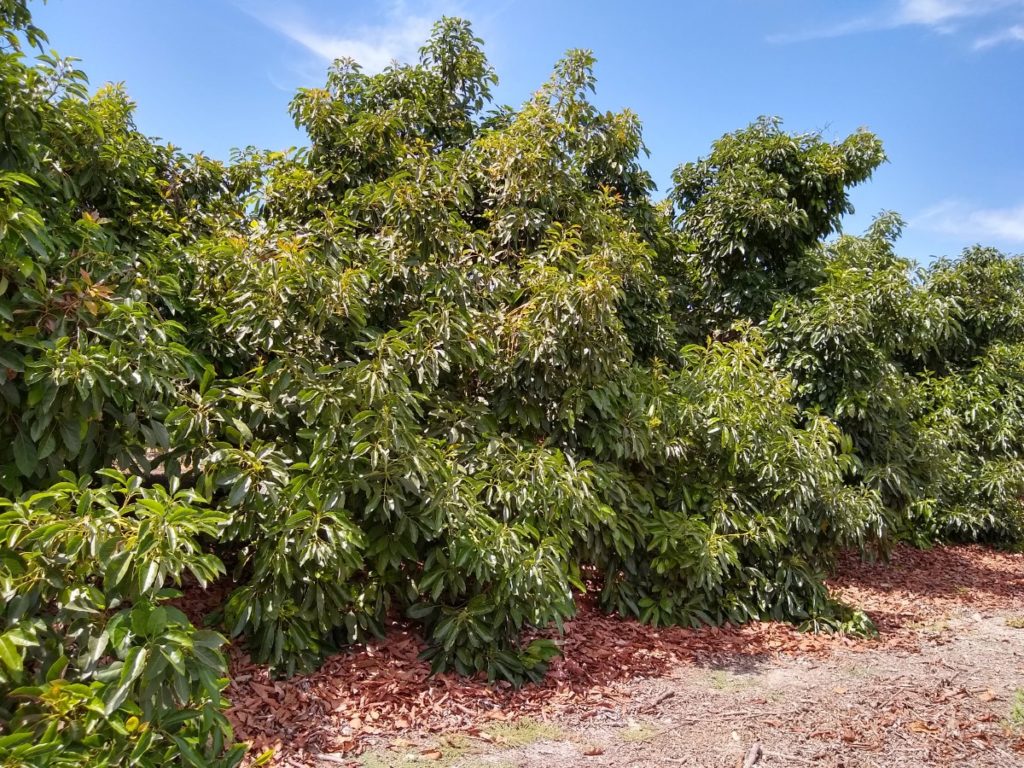
The photo below shows the same trees from under their canopies. A spacing of 15 feet between Hass trees is manageable with some pruning; you can get a wall of green (privacy screen from the road or neighbors, for example) and one that provides oodles of avocados.

I’ve attempted to do something similar in a couple parts of my yard. Below are a Reed and Lamb planted only 7.5 feet apart back in 2013 (so seven years old in this photo), and then more recently I added the small Hellen avocado tree on the right and a multi-grafted avocado tree on the left. Eventually, they will look similar to the Hass trees at Cal Poly above.

Planting avocado trees only 7.5 feet apart means that you must either let their canopies merge or you will have to prune yearly if not twice yearly in order to keep them growing as independent units.
Here are three avocado trees planted in front of a house in Carpinteria that form a green screen. From left to right: Fuerte, Bacon, Pinkerton.
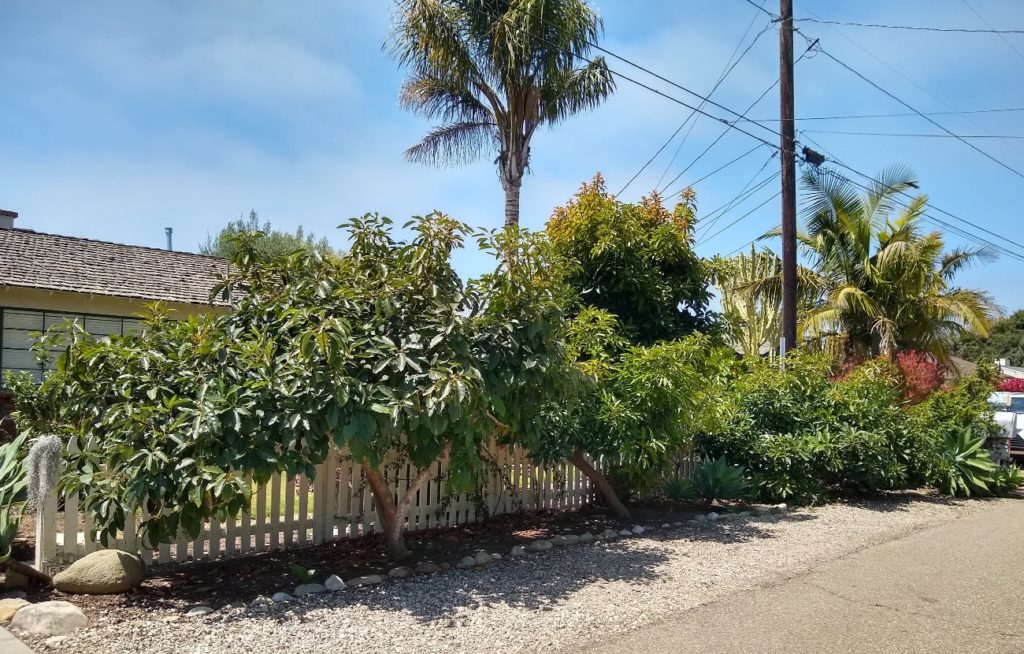
The trees are planted about 10 feet apart, and the Fuerte and Bacon canopies are touching but you might notice that the Pinkerton on the far right is much shorter than the other two and is not yet touching the Bacon.
It’s possible to plant avocado trees even closer than 10 or 7.5 feet apart and keep them productive and healthy, especially if you’re planting only a pair. Below are two avocado trees that look like a single tree.
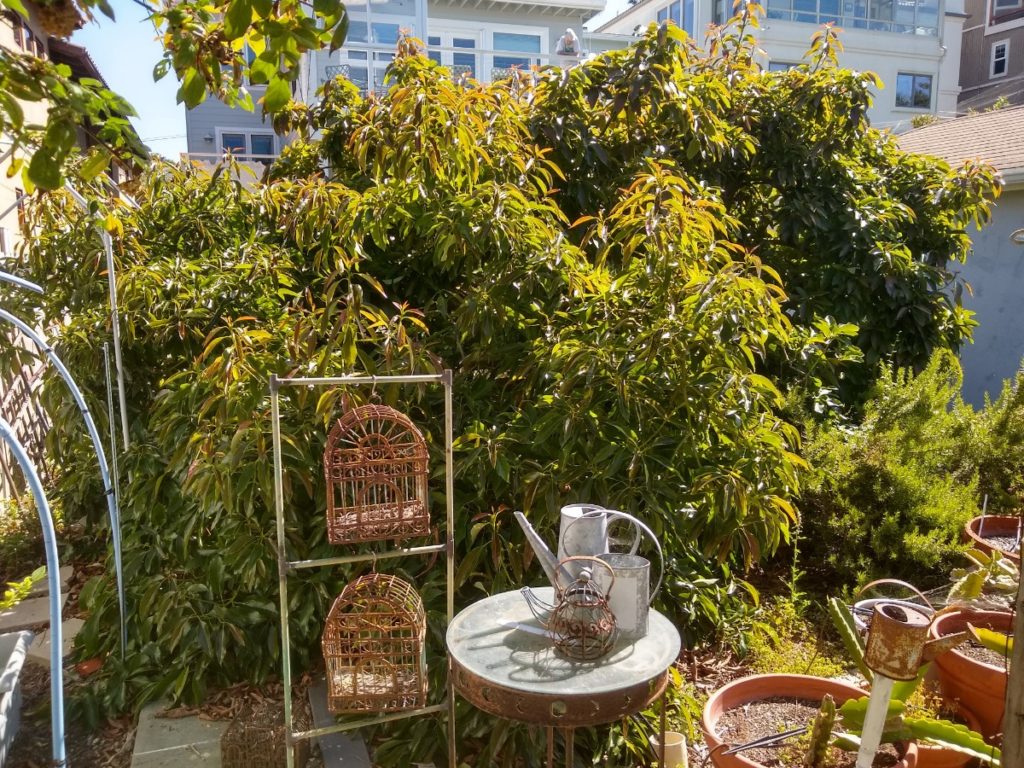
But actually, the foliage toward the front left is a Holiday and the foliage to the back and right is a Don Gillogly. Wisely, the Holiday was planted to the southwest of the Don Gillogly, as Holiday is a far less vigorous variety and it would get shaded out by the Gillogly.
Here are the trunks of the trees, only a few feet apart, looking from the opposite direction:
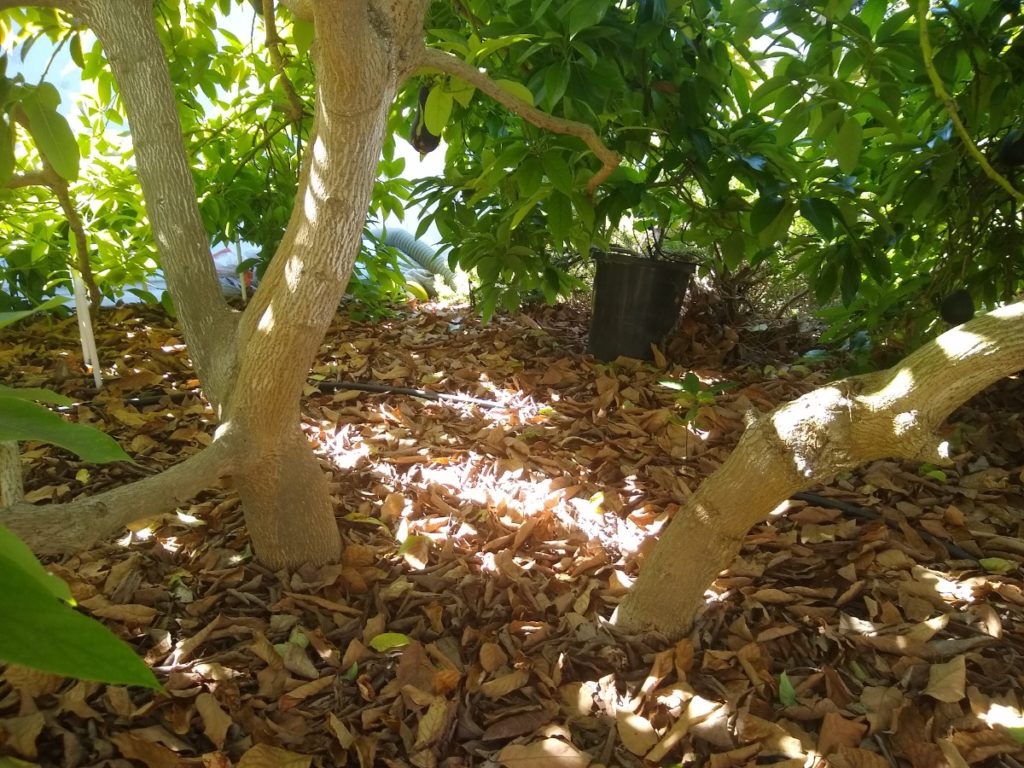
Does the avocado tree below also look like a single?

Surprise, surprise! Look inside and you’ll find two trunks:

Those trees were planted so close together that only a single hole was dug in order to put them in. They were since trained and pruned to become two halves of a unified canopy.
Planting two trees of different varieties in one hole is a great option for a yard with little space or for a person or couple who only need one tree’s worth of avocados. To make this planting style work best, the varieties should be of similar vigor, the varieties should have different harvest seasons, and — of less importance — one could have an A-type flower while the other has a B-type flower (in order to get maximum pollination potential).
(For help choosing varieties for such a planting, see my posts “Avocado varieties for year-round harvest” and “Avocado variety profiles.”)
Or you could get even more clustered . . .
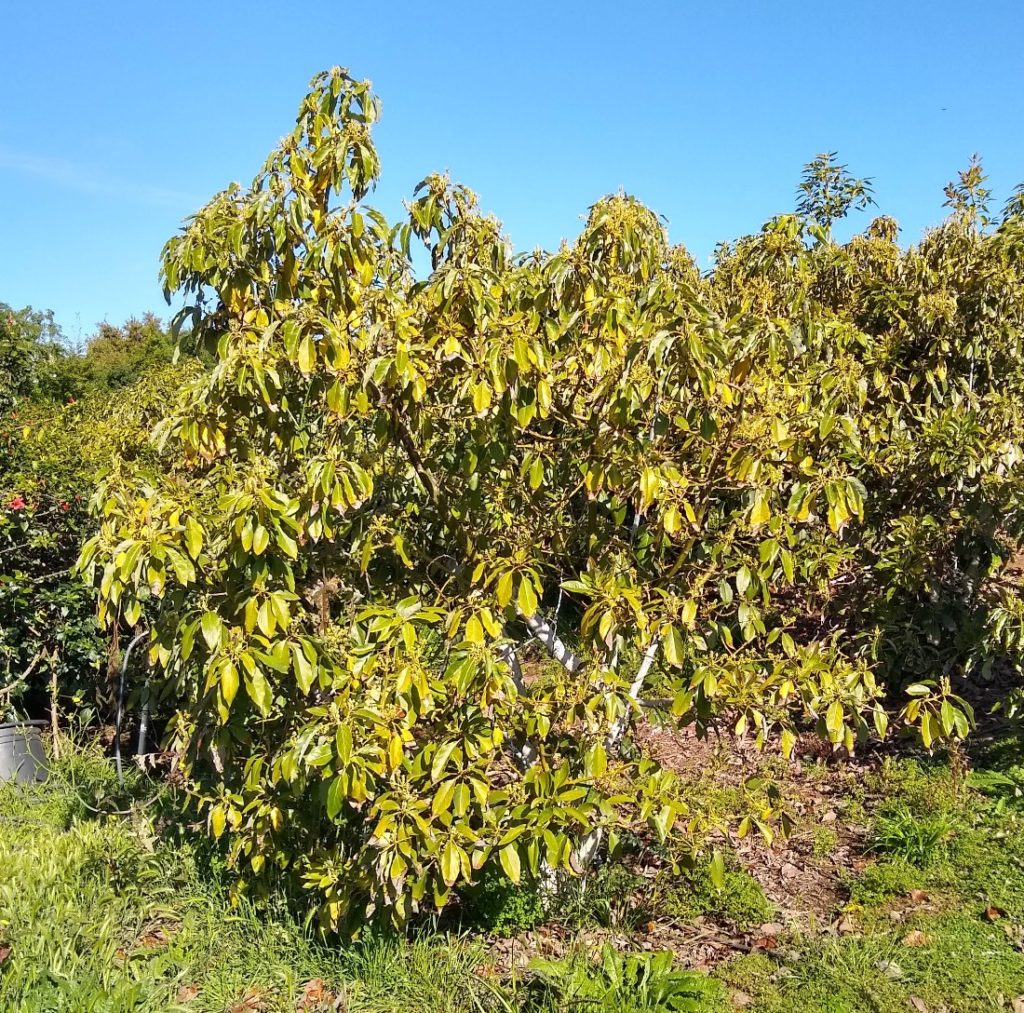
That is a three-in-one-hole planting. See the trunks below:
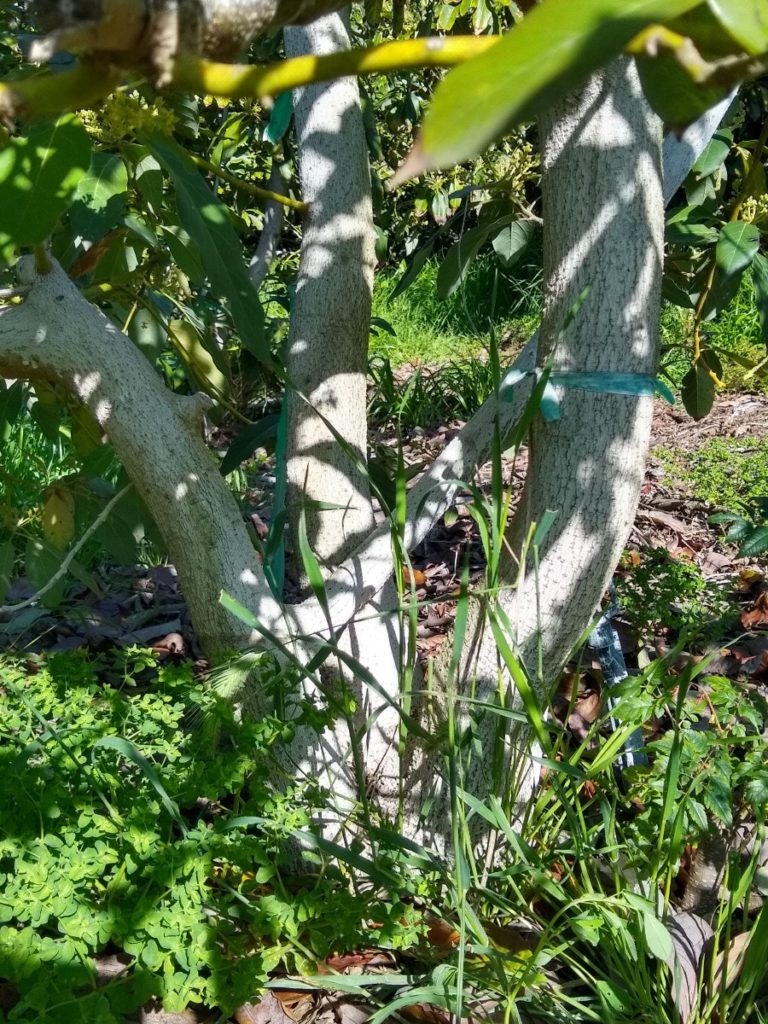
Could you even do four in one? Sure, why not.
With these plantings of multiple trees in one hole, the challenge is similar to a tree with a single trunk/rootstock that has multiple varieties grafted onto it, which is in attentive pruning. You have to be sure not to allow a more vigorous variety to overwhelm the others.
Pairs of avocado trees
Here is a video where I show and talk about managing the canopies of avocado trees that are grown in pairs:
How close to other trees in a grove setting
In a grove setting, avocado trees are normally spaced much farther out. Long ago, the standard spacing at planting was 20 feet. Then when the trees got big, every other tree would be removed so there were 40 feet between them. These days, it is more common to plant more closely.
The planting below has trees spaced about 18 feet apart. The plan with these trees is to prune them once they start to become crowded but never to remove any. They will be pruned such that each tree can be accessed on all sides.
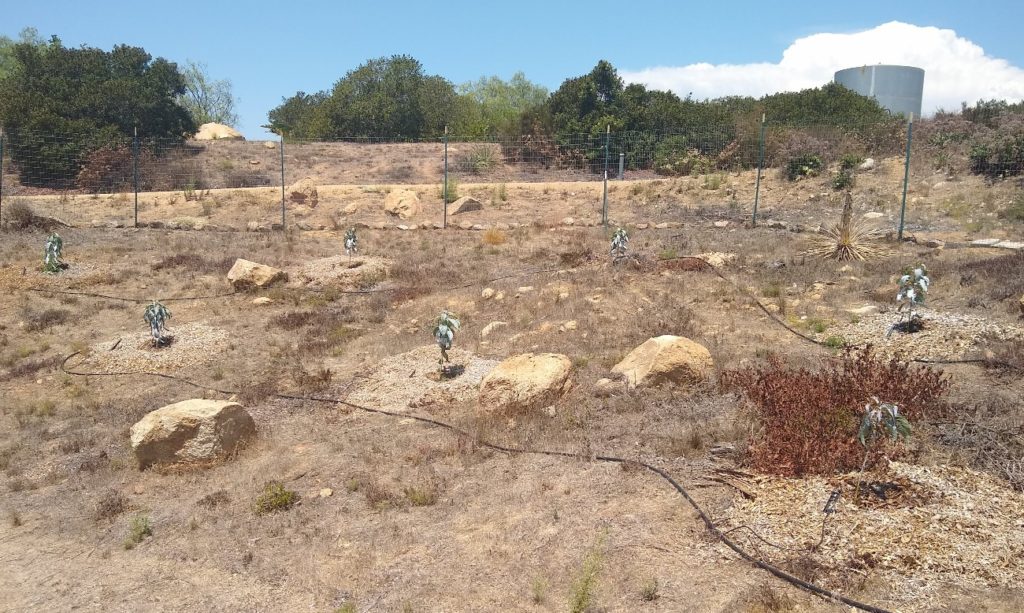
The planting below has trees spaced 12 feet apart within the row, but there is 15 feet between rows so that there is an aisle for access.
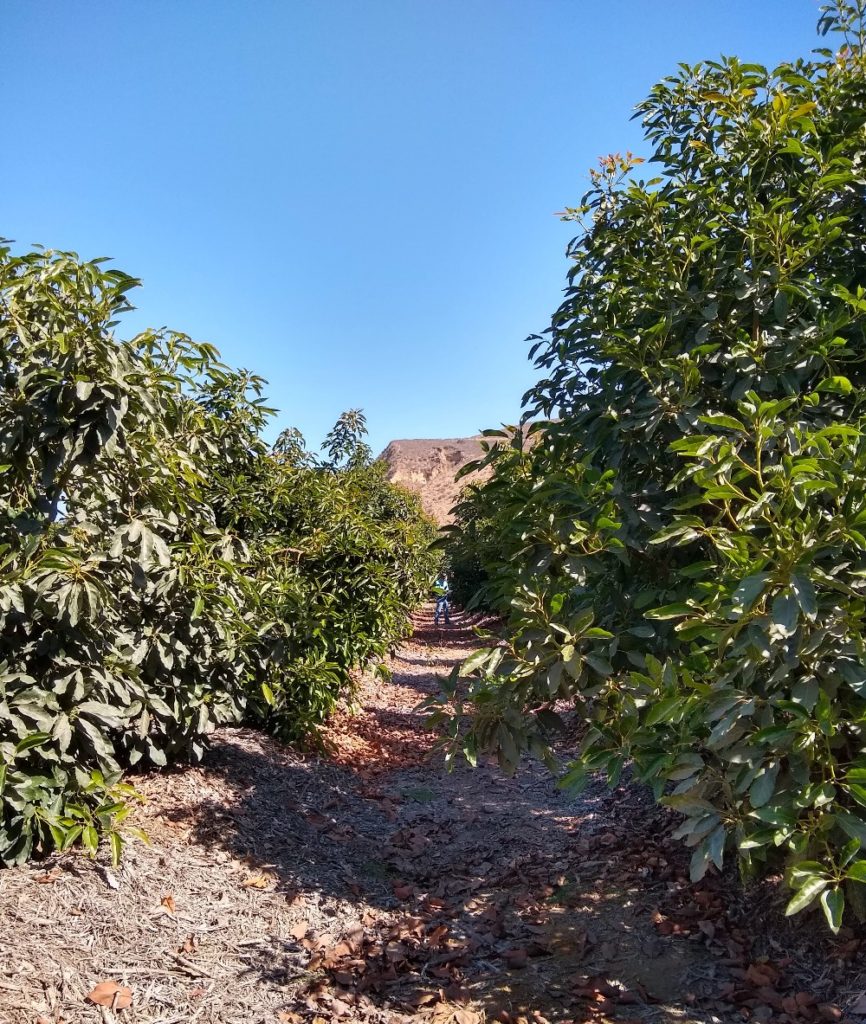
This planting is in Ventura County, it is seven years old, and there are multiple varieties within: Hass, Carmen, GEM, Reed, Lamb.
Below are trees that were recently topworked. In other words, older trees were cut down to stumps and then a new variety was grafted onto the stumps. In this case, the previous variety had been Hass, and the new variety that you see growing here is GEM.
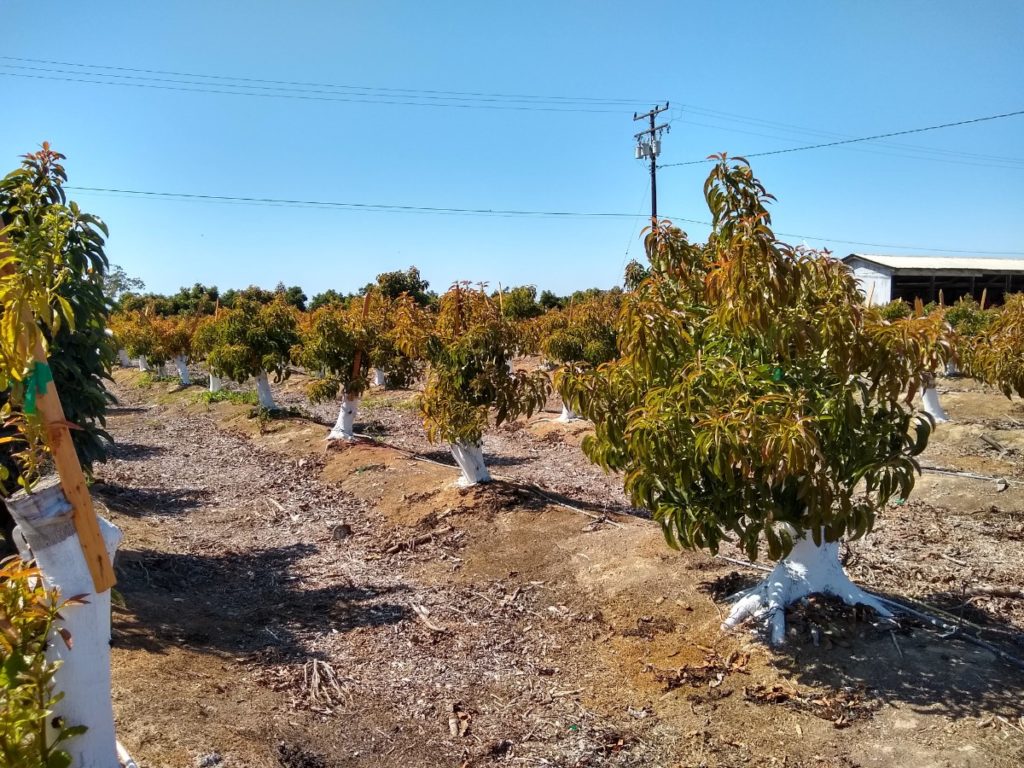
The reason the above trees were topworked is that the grower found it too difficult to manage the Hass trees at such close spacing. The trees were planted only 10 feet apart down the row. After about 9 years, the trees required such frequent pruning that it was hard to keep up and the trees’ production declined. So 15 years after planting, the grower topworked the trees to the less vigorous variety GEM, which can more easily be grown long term at a 10 by 10 spacing.
Going in the opposite direction, the avocado trees below were also planted at a 10 by 10 spacing, this time with the Reed variety, but the grower felt he could fit more trees in — at least during the early years — so he recently interplanted new avocado trees making the spacing only 5 feet by 5 feet. See the small trees in between the big trees?
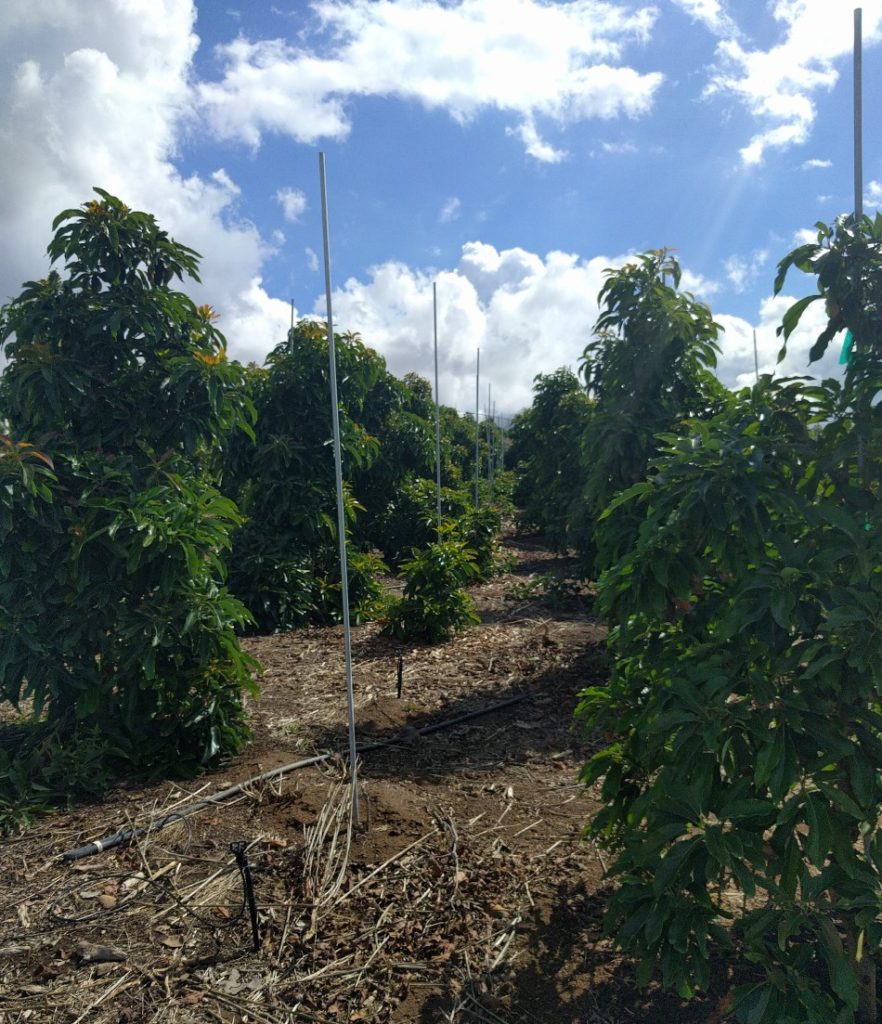
Don’t want to waste any expensive real estate, eh? Even farmers have space constraints; it’s not just we home gardeners.
All of my Yard Posts can be found HERE.

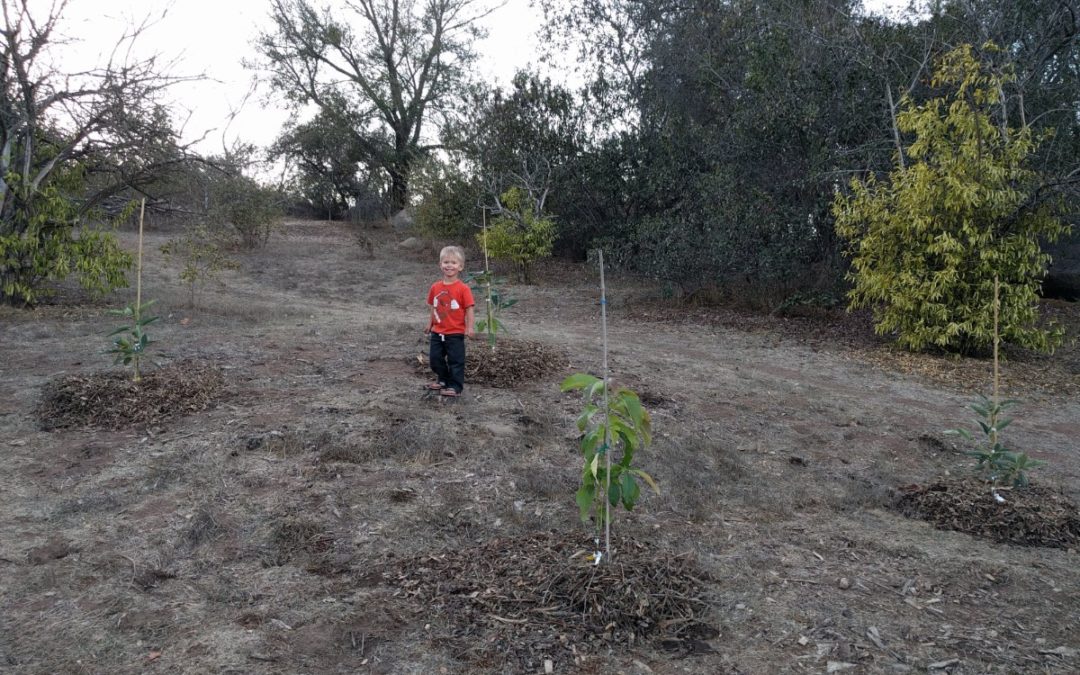


I buy a lot of my trees from BayLaurel nursery. They also have some great tips and there help staff when I call are great too.
Anyway, one of their suggestions for people with limited space or those who don’t want large trees is to plant same type trees in the same hole. This has worked well for me with Peaches. This year I decided to try it with a Fuerte and Hass avocado tree. They are growing very well. I prepared the hole by digging down 4 feet and 3 feet in diameter. I lined the hole with Chicken wire and refilled the hole with amended soil. This takes care of the gophers and my poor clay soil. What are your thoughts on this method
I would think you dug way too deep. Most roots grow in the top 2′. I would also plant at least 6″ above grade in a mound.
Hi Kevin and Gregory,
I second Gregory’s thoughts here. In addition, amending the soil in the planting hole was probably not helpful at best.
Here are my thoughts on planting avocado trees: https://gregalder.com/yardposts/how-to-plant-and-stake-an-avocado-tree/
In that post you’ll find a link to an interesting report on research done in California and New Zealand called “Avocado Planting Systems.” It’s an excellent read for anyone planting avocados.
Where can I purchase a Little Cato that are both A and B? I live in Glendora, Ca.
Hi Gloria,
I would head over to the Armstrong on Alosta/Route 66. They might not have a Little Cado (also called Wurtz) in stock, but they can order one for you from La Verne Nursery.
I just bought Little Cato from Home Depot in Laguna Niguel. They seem to have them at Home Depots right now. all grown at La Verne Nursery. They are labeled Dwarf Avocado.
Your article on spacing between avocado trees of such wide varieties was super helpful to me since I had fears that I planted many of my trees too close together.
My fears was regardless of the deliberateness of my decisions and was imposed only because I was hearing too many stoooopid comments and I personally did not have experience of examples I now have to convince me that my theoretical knowledge does work in practice….always.
Just to add to my comment. I’m in South Africa and I’m in the beginning of experimenting with my new passion which is planting avos.
I deliberately decided to plant my trees closer together than the norm so that they can shade each other from the strong South African sun early in their growth.
However, i like pruning and training of trees and was never going to allow them to grow unchecked.
Hi Stafford,
I like your approach. I bet you’ll have fun manipulating the shapes and sizes of the trees as they grow older. And if it turns out that you did plant closer together than you’d like them to be long term, you might remove every other tree. Wish you luck and lots of avos.
Hi Greg,
Is it ok to plant bacon and fuerte two in one hole? Then 6 feet away Gem?
I’m in North California (Humboldt Country) and have a Wurtz in the ground for about 6 years and got only 1 pea sized avocado which dropped. It weathered our freak snow last winter and is growing green and healthy – but hardly any flowering (April May). If I had to do it again, I’d pick another cultivar.
This is Awesome! thank-you, I live in suburbia, with a large backyard, but less than ¼ acre. I have 8 young Avocado trees now, and I want to put another 5 more in and maybe 7 more!!! This really helps me figure out how many Avo trees I can manage on my lot. I am going to have to get good at pruning someday ; )
I think I will create 2 big hedges , that will help with privacy as well and provide some shade, I just hope my neighbors do not mind, hopefully I can prevent them from hanging too far over the fences. I’ll plant ~5 ft from my fences.
I have been interplanting a food forest, based on Permaculture Orchard “trio” method, So I plant 3 different trees or bushes together near each other by several feet, and one of them has to be a nitrogen fixer, and I try to include some native plants in the trio and understory. So I have been interplanting Bananas and/or Plantains with Avocados spaced 8 to 12 feet apart, and then planting (native) Amorpha Fructosa in the shady understory behind them which is a nitrogen fixer, and it is a host plant to dogfaced butterfly caterpillars. They are thriving after 3 years!! Bananas out our ears! Behind that row higher up on the slope where is it dryer, I planted Toyon, Fairy duster, and ceanothus (a nitrogen fixer), and at the top of the slope, I planted a hedge of 2 trios of pomagrante, macadamia, and Catalina Ironwood (a native nitrogen fixer), these will get very tall someday. I mainly just water the macadamia nut trees and any excess water travels downslope to the bananas and avocados, it is working out amazingly well.
I love your posts, thank you so much,
What varieties of avocados are you growing?
I just Purcahsed a Gwen
And was told I
To pair it with another for pollination I do not have much space and would prefer a type with dark skin ripening over green
Type fruit. I would like to shape them as trees not bushes due to space in my front yard being small.
Great choice, Dom. I love Gwen. Where did you purchase the tree?
Gwen has produced well without other kinds of avocado trees nearby in some locations. Anyway, black avocados that are also B types are very limited. Sir-Prize is the only one I can think of that’s widely available. Nimlioh is another that you might be able to find.
Robin: As far as avocados go I wouldn’t worry about “Nitrogen Fixation” if you don’t rake up any of its leaves. Avocados roots love to feed on their own decaying leaves after they get established.
Hi Robin,
Very interesting. You’ve definitely caught the avocado bug too. I’d love to continue hearing updates on how those trios are growing.
Hi Greg- Love your articles and enjoying reading them.I have few questions -how can I ask you ? email or phone ? let me know. about my orange tree(very healthy looking 10 years old two trees side by side but not Oranges this year Why every year lots of them but not this year.?
Hi Kioko,
Thanks! You remind me that I should write a post noting all of the possible reasons that fruit trees don’t produce fruit.
As for an orange tree taking a single year off like yours, it’s not so uncommon, and it’s often related to bad weather or the previous year’s crop having been particularly heavy. Either of those seem likely in your case?
Greg: What is the season for that Gillogly and how do you like it’s taste?
I just planted a small 5 gallon one in Sylmar where high heat is now my main problem.
Hi Dal,
I did a video profile of the Don Gillogly avocado this spring: https://youtu.be/hj7UoYkr32Q
Let me know if I didn’t answer any questions in that video.
How is your little tree handling your Sylmar summer? I don’t know much about how the DG handles high heat. I don’t currently grow the variety in my yard.
I envy those who have mastered the art of avocado growing. I think my Pinkerton and Stewart planted last fall caught and are going to do well. My Lamb Hass has looked like a mess for 5 or more years but the Fuerte I got at Maddock is doing really well. I’ve found that if I plant them in a pile of decomposed granite a little above grade and then cover them with 6 inches of the free city compost it does wonders. I’m on my way to start adding varieties near each of the ones in the ground. I’m on a third of an acre near SDSU so can only plant so much.
Hi Greg, Great topic and post. I’ve seen lots of posts of people planting avocado trees in pots. Some are legit: balcony garden, rental, or wrong climate. However many are planting in pots because they see so many posts of others doing it. So just a reminder that if you want a long term vigorous avocado tree, best to plant it in the ground.
Hey Greg, I don’t know where to ask but I have a question about identifying if something is hass or the rootstock.
Hi Dylan,
I do have one photo of an avocado tree (Fuerte) with a rootstock sucker in this post: https://gregalder.com/yardposts/reading-avocado-leaves/
See if that gives you a clue. If not, ask a specific question there and I’ll do my best to help figure it out.
Hello. lovely article I just bought a Hass and will find a type B maybe a Brogdan or Furente (which is better for guac?) and plant both in a hole close together to maximize my little space. Thanks for the info
Could the same method of 2 plants in a hole be used with Mango trees?
thanks!
Hi Greg,
I love the post! For some reason, I was possessed to plant our three trees (A Bacon, Hass, and Sir Prize) about four to five feet from each other. I would like our trees to be happy and productive, should I move them or just try and manage them as they are? For some context, I live in the SF Bay Area.
Hi Mac,
If you have the room, and you want each of those trees to produce fruit long term, then I’d move them. Note that I just added a photo to the post above of a Fuerte, Bacon, and Pinkerton combination planted about 10 feet apart. That spacing would be more manageable with your varieties too; I wouldn’t try any closer unless you didn’t want much fruit from each tree.
I planted Hass, Lamb Hass & Fuerte trees a foot apart, at the advice of a newspaper garden columnist. The speculation was that they would grow together and share a common trunk. Each was 3-5 years old at the time we purchased them from a nursery, and the tallest was the Hass, so we planted it on the North so it didn’t overshadow the other two. After two years of growth, the Hass died in the July 2018 heatwave. (We were on vacation and left instructions to hand water twice that week.) The other two survived and we harvested 1 Lamb Hass avocado that year, 4 the following and 9 this year. There are over a dozen large healthy avocados this year. The Fuerte has yet to produce. I’m now researching when and how to prune them for optimal growth and production.
Hi Greg, I am a New Zealand want – to – be grower of avocadoes, any chance you would know what the best avocado trees to plant in south Canterbury ? I want to plant in the garden next to my house its one of my most sunny spots, any suggestions are welcomed
Hi Carmen,
Wish I knew! That would mean I’d spent some time in New Zealand. But sorry, I only know what I’ve read about growing avocados in your area. What I’ve read is that one of your challenges is low temperatures during spring bloom so commercial farmers plant tall trees as windbreaks in order to try to raise the temperature within a grove and enhance pollination. With that in mind, I’d guess that A-type varieties would do better than B-type varieties. Since you’re down south, this is probably an even bigger factor.
I’d try Hass? I’d also try Reed? Just guesses.
Hello Greg, I love your website, it is so full of useful information and I love that you add pictures.
I live in Gilroy, CA and in the winter the temps drop to the low 20’s at times, but does drop below 32 more often. I love the haas avocado and just recently purchased a Lamb Haas tree that is supposed to be cold tolerant to 30º. I plan to wrap it with older Christmas lights and some plastic during the nights to help keep it warm. Which other Haas tree do you recommend to plant with it so they can produce more fruit and tolerate the cold? I prefer the avocados that can peel easily and have a similar taste to the Haas. I also plan to plant two trees in the same hole, just like in the picture. I was thinking of not planting the tree right now, but rather waiting for spring after the frost passes or should I plant now and give the tree a head start before winter?
Do you know which variety avocado tree give the cocktail avocados?
Hi Luis,
Thank you. I haven’t noticed Lamb showing more cold tolerance than Hass in my own yard, at least not in terms of holding its fruit. For example, last winter we had a night down to 25 degrees, and my Lamb dropped a lot of fruit but my Hass didn’t drop any; both trees are on the same rootstock and are the same age and were carrying moderate crops so I think the comparison is worth noting — although I’m not about to say that Lamb is less cold tolerant than Hass absolutely. I would suggest you try Hass in your yard if your Lamb ends up growing well though.
Getting the trees through their first couple winters is the most important and most laborious in a colder location so I would wait until spring to plant if I were you. Bigger trees are tougher in the cold.
Other varieties that taste similar to Hass include GEM and Gwen. GEM and Gwen both seem to have a tiny bit more cold tolerance than Hass, maybe, as far as observations in my own yard go, along with stories from elsewhere.
Cocktail avocados are Fuerte avocados that haven’t been completely pollinated, and so their seeds don’t develop (although they still have a seed cavity inside).
Hi Greg
I love your website it has gotten me really excited about planting different varieties and receiving a year around harvest. We live coastal (Mandeville Canyon/Brentwood LA) area. I have a small hillside area south-facing on my front yard.
1. I would love to plant 6 more avocado trees for a year around harvest: Pinkerton, Fuerte, Hass, Gwen, Reed and Lamb. I could plant them about 5.5 feet (+/- .5) apart. My thinking is I can prune them as they grow and once established after 5+ years, when harder to prune, I could cut 1-3 trees off and keep the more successful ones that would still give me a year around harvest. Do you think a 5.5 feet distance is too close? Would you rather plant 3 in one hole? I am trying to maximize largest harvest in smallest amount of time :).
2. Are there any other varieties that do better in coastal areas than the ones above that i could switch out?
Thank you so much for your advice!
Hi Jessica,
Thank you. I think the 5-6 foot spacing is good. You’ll have to prune after a couple years, and then you’ll decide on which trees to keep and which to remove a few years after that.
Likely, there will be a dilemma at that point because you’ll want to keep two trees that you planted next to each other. Oh well. Or maybe you’ll get lucky and your order fits with which trees are your favorites.
Anyway, I would plant like this rather than three in one hole because it will be easier to manage.
I think all of those varieties should do well for you in your location. The Pinkerton and Fuerte are likely to bloom early and so you’ll get some early fruit to harvest from them, starting around this time of year (Thanksgiving) each year. And then your Reed and Lamb should hang until this time of year such that the end of their season runs into the beginning of the Pinkerton and Fuerte season. I wouldn’t count on this happening every single year, but the potential is certainly there.
Hi Greg,
Thanks for your helpful information you continue to provide so generously. I have a Sir Prize (~4′ tall), Sharwil (about 2.5′ tall) and Lamb Hass (~1.5′ tall) planted about a foot apart in a triangular arrangement. They have been in the ground for almost a year. The Sir Prize and Sharwil are doing fine, budding out now. The Lamb Hass is struggling. It really hasn’t grown much and no sign of perking up. It is located on the south side of the other 2 trees. The question is do I just leave the Lamb to see what happens or try to replace it? If I try to replace it am I risking harm to the other 2 trees that are doing well by digging out tree and planting another one? Thanks for your insight.
Hi Kyle,
I’m inclined to suggest you replace the struggling Lamb. I can’t see what excuse it would have for poor growth considering that it’s got the prime south location and the other trees are growing fine. Lamb trees are also not extremely hard to come by.
You should be able to remove the tree without doing much damage to the others if you don’t try to dig out all of the roots. I would only dig out what is necessary in order to plant the new tree. Since the Lamb hasn’t grown well on top, you’ll probably find that it doesn’t have a large root system down below either. Here in late winter is a perfect time to do this job since if you do disturb the roots of the other trees, they won’t have stressful weather to deal with as they recover. Best of luck however you choose to proceed!
How many years before a grafted Hass bears fruit in Brisbane, Queensland? I have three grown from seeds about 30 ce,ntimtres (12”) tall in pots but I don’t meant to wait ten years for fruit.
Greg, Thank you for the very helpful information. We recently had the septic system replaced on our house we just purchased, and were wondering if an avocado tree roots might damaged it if planted close to either parts. But after reading a few of your articles, it sounds like it shouldn’t be an issue, correct?
Hi Sarah,
I can’t say for sure in your case, but I have avocados near my leach lines and I know others who do and have never experienced or heard of problems because of it.
I was recently gifted a GEM avocado tree, but only have 3×3 space in my yard to plant it between a brick wall and concrete. Would you suggest planting it in the ground or in a large container?
Useful information. thanks for sharing.
I planted my fuerte a few months ago and their is a branch growing from the graft line, but i dont think its part of the root stock. Do i trim it off or let it go? We planted the tree with intention of a beautiful tree that also blocks the neighbors out and give privacy (its probably 10 feet from the fence). We want kind of a sprawling tree that is just as beautiful to look at as well as productive with fruit. Thank you!!
Hi Michelle,
Might as well cut it off to be safe. Also, the height of that branch will never change and it’s more convenient for irrigation and other reasons if the lowest branches start a little higher — about knee height is a good rule of thumb. A Fuerte will still naturally sprawl even if the lowest branches are well above knee height. By the way, I’m not necessarily saying that you should remove all branches below knee height right now because they can be temporarily useful in shading the trunk. You might like to check out this post for more on the topic of training young avocado trees: https://gregalder.com/yardposts/training-young-avocado-trees/
This is a great post! Have you ever seen avocados grown in raised concrete beds (with rebar and cement)? Is there a worry that it could push through the structure?
Hi Amy,
I can’t recall seeing avocados in raised concrete beds, but I don’t see why it wouldn’t work as long as the drainage of the soil inside is sufficient. I wouldn’t worry about avocado roots pushing through the structure as long as it is more than a couple feet wide.
Hello Greg,
Love your posts on growing avocado trees, they have been so helpful and informative. I recently got a Reed and looking for a spot for it. My yard is mostly pavers with planter area roughly 3.5 feet from the house or from a wall, which is enough for a palm or fern. Do I have enough spacing for a Reed, since it’s a relatively smaller size variety? Or it’s best to keep it in a container?
I have a small space, but I bought a Fuerte! I hadn’t realized how big they get. I’m going to have to keep that baby well-pruned in a 2-meter square space. There is room for upper branches to extend in two directions, south and west. There is a small road on the other side that cars need to get through. Will severe, regular pruning make it hard for the tree to produce fruit? Also, I could just break down and buy a Mexican Grande or a Pinkerton to plant with it, but am I really pushing the limits of practicality that way? I would be buying the other tree to both provide a pollinator and extend the harvest. I don’t know which tree would be better. Both apparently pollinate at the same time, but which one would have a similar vigor to the Fuerte? I am in zone 9b, so I am limited with which varieties I can grow, but I know the above varieties would be able to handle our climate. I don’t need a huge harvest, but I have also heard that Fuertes are sporadic fruit setters, so I would benefit from a variety that would give me avocados every year. I could also graft onto the Fuerte, but I have read that planting two trees in a close/same hole is a more successful strategy. Should I just give up on growing two in one small space and enjoy the Fuerte in the years it decides to grace me with fruit?
I need like a visit to give me some guidance and advice on layout and planting Various kind of avocado trees. I live 2 miles from Sycuan Casino. My lot is 1.6 acres. I do not expect a free service.
Hi Bill,
I’ll email you about a possible visit.
After going on a major search and acquire mission to find one Reed tree, I found two in a matter of days at the most unlikely places (Home Depot and Lowes). I planted the best of the two… but now I’m trying to find a home for the other, and the best location is 5 feet from the first one, and rather close (4-5 feet) from a wall. I’m thinking I can make it work as I was planning to keep the Reed at 10 feet high max. Thoughts?
Hi Eduardo,
That spacing can work easily for the first five years or so, but beyond that it will require a lot of pruning.
Hi,
I just planted a Little Cado. Can I expect a good harvest from a single tree? I’ve read that they are both A and B so only planned on just one but wonder if that’s wise. What would you do? Thanks
Hi Dee,
I’ve single Little Cado (Wurtz) trees producing fine on their own. It can never hurt to plant a second tree of a different variety though.
I submitted a question before about a reed that was not doing anything since it was planted a year ago. Its about 20 ft from an good sized oak. I decided to plant another reed about 10 ft further from the oak. When I was digging the hole I still found some oak roots about an inch wide. I cut these and decided to shelter my new reed from the oak roots with a underground rock flagstone wall about 3 ft deep. Have you had any experience with this? I also amended my soil with some gypsum, peat, and white perlite. Also do you use drainage pipes in a vertical position about 3 ft from your trees to get air to the roots and keep the area from getting soggy?
Hello Greg,
I love this post; because, it demonstrates that some avocado trees can thrive in locations that are typically not recommended. Are you aware of any research that has been done regarding planting avocado trees in lawns?
Appreciatively,
Olivia
Thanks, Olivia. I’ve never encountered such research. Actually, I’ve only encountered advice that says not to plant avocados (and other fruit trees) in lawns. Maybe I should throw together a post of just photos of avocado trees growing very well when surrounded by lawns.
Greg, On behalf of Ken Hennell, avocado farmer in Southern California and myself, home avocado grower on the Central Coast, thank you for your reply. I, too, have only read the recommendations to not plant avocado trees in lawns. It would be great to see a collection of photos featuring avocado trees thriving in lawns.
I value your expertise and the valuable resources you provide for avocado growers in your Yard Posts and videos. I frequently share your information with members of our avocado group and CRFG Chapter. Thank you for your work and for taking the time to reply to questions from avocado growers.
Thanks a lot for the kind message, Olivia. I appreciate all of your input and challenging questions. They help me think about new angles and learn more. I’ll go through photos this week, and if I have enough I’ll post a collection of avocado trees in lawns. Otherwise, I’ll photograph a few more before publishing.
Hi Greg,
I think you might enjoy meeting Ken Hennell and visiting his orchard. He has been a successful avocado farmer for over 40 years. Like you, he’s kind, knowledgeable, and passionate about continually learning more about avocados. He’s currently exploring avocados from Hass seedlings that grew from fruit that abscised naturally or were blown off the trees by the wind. The link below includes a photo of 4 very different avocados from Hass seedlings in his orchard. I contacted Ken, and he would be happy to meet you and have you visit his orchard. If you’re interested in visiting, I can provide you his contact information.
Best,
Olivia
Hi Greg,
I am in SO Ca, in the Spring Valley area. As a family we are trying to maximize kids space and plant space in our backyard. We primarily container garden due to gophers, but have a dwarf lime and orange tree in the ground. We recently bought a Haas avocado tree, and a 4 in 1 stone fruit tree. I would love some input on planting locations. I’m worried about planting the new trees too close to the dwarf trees, but if I expand out wards the 10-20 feet from the existing trees, I impact play area for my kids. Do you have any suggestions on spacing distance from the dwarf trees?
Thank you!
Alyson
Hi Alyson,
You can keep the lime and orange tree pruned to any size you want. So you should decide how big you want them to get first. (By the way, our lime tree is only about five feet by five feet and we can’t eat all of its limes.)
Then decide how big you want the others to get. I would allow at least eight feet in width for the stone fruit tree. I would allow at least ten feet in width for the Hass avocado tree.
Hi Greg, we have followed your guide to growing avocados for last 4 years. Currently live in Simi Valley. First timers growing avocados. Our 2 Hass trees are 4 years. One produced fruit last year…20 i believe. It appears the fruit doesn’t “set.” Is there anything we should be doing to improve fruit production? Thanks Mark
Hi Mark,
I’ve been thinking about writing a post on reasons that avocado trees don’t set fruit or set little. Until then, here are some ideas to consider.
Did it flower a lot? Don’t expect fruit unless it flowered a lot. (An avocado tree that flowers only a little almost never sets any fruit.)
Did you see bees and/or flies visiting the flowers? (Avocado flowers require an insect to pollinate them in California.)
Did it set fruit (about pea size) and then go through a heat wave? (Avocado trees, especially Hass, are very prone to shedding small fruit if they get heat stressed or thirsty.)
I live in Roseville, California….southern Sacramento Valley. And I love avocados.
Bought a Mexicola Grande from Four Winds Nursery about 4 years ago. Chose this variety for its purported cold tolerance. Our winter nights dip to high 20’s a few times a year. Summer days are dry from June-Oct and daytime highs can reach 100-110F several days in a row.
My single Mexicola Grande (type A) has grown nicely in 4 years, now about 15 ft high with on-going growth. In 2021, I was excited to have about 8 flowers that looked like thy had fertilized and produced “fruitlets” that got about 1/4 inch in size before the stem to the fruitlet died back and they all dropped. In 2022, same story but I had more like 50-80 of the swollen flowers’ base in about April, but by May they had all shriveled and dropped……SO disappointing after getting my hopes up of SELF-RAISED avocados!
Is this a problem with climate, fertilization, type A/B cross-pollination……or something else?
The tree’s growth suggests it is otherwise happy. I’m currently thinking of planting a new Fuerte (type B) variety tree about 12 feet away……but wanted your worthy opinion as I’m avocado-driven!!! Thanks, SJW
Hi Steven,
This week’s post is made for you. I’ll give you some ideas as to why your Mexicola Grande hasn’t given you a crop yet. Look out for it tomorrow.
Hi Greg,
I’m in San Diego and thinking about planting a pair of avocado trees. I came here looking for guidance on how close I can plant them (to see if I would have enough room) and hit a gold mine! There are only two of us in our house, so we don’t need massive numbers of fruits, and the idea of planting a pair in one hole especially caught my eye. Would a Hass and a Reed be a good match? And if yes, would any particular orientation be optimal? I have a very sunny corner of my backyard that is reserved for avocados. Thanks so much for all of your hard work and very helpful posts!
Hi Greg,
Thanks god all your interesting information on growing Avocados.
I’m in Perth Australia
I’m planting my first avocado. Based on your recommendations I’m planting a Hass. Probably against your recs I’ve found a mature one, 10 years old, so I can get fruiting quicker.
I was now considering experimenting with planting two or three young avocados, in the same planting hole. I was thinking of planting a Read and a Fuerte. This is with the thought of improving Pollination and extending my season. I also wondered whether to put in a Sharwil as another B if the fuerte has a bad year. So all three in the same planting hole.
Do you think this is a good experiment?
Would you recommend anything different?
Thank you so much for your thoughts.
The three avocado trees in my backyard were planted 10-12 ft apart before we moved in. The canopies are now joined. Is that ok, or is it better to prune and keep some space between?
The right side is Haas, the left Bacon. The one in the middle is round…any idea what that might be?
Hi Michael,
If you don’t prune to keep some space between the trees, over time the lower canopy will stop making fruit and then die because of the lack of sunlight there. There is no right or wrong to whether you prune to keep space between the trees. It’s just up to you and how you want the trees to grow.
I live in hawaii on Oahu and have small backyard with a couple citrus trees and room for one more tree I have a Sharwil Avocado I want to plant. Are there any tips to help keep the tree small like to reduce damaging the foundation of my house? I was gonna plant a mango but I have seen how much damage they can potentially cause with their size are avocados a better choice?
Thanks